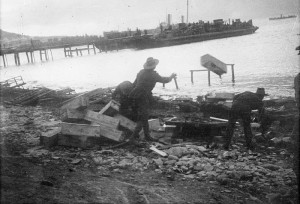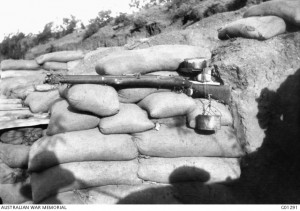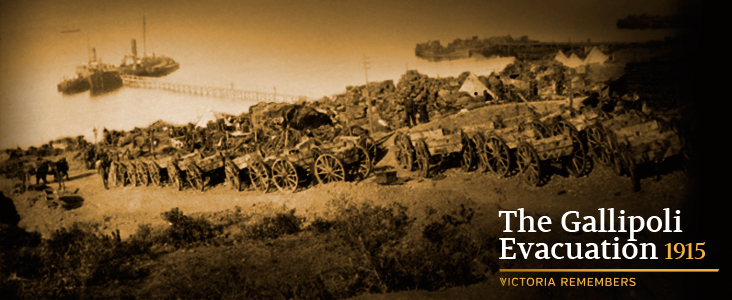The Gallipoli Evacuation
In November 1915, the decision was made to evacuate the allied troops from Gallipoli, Turkey. By 20 December 1915, a little over a month later, the last of the ANZAC troops had been evacuated from Anzac and Suvla. The men who had survived Gallipoli would go on to celebrate Christmas on Lemnos, but the celebrations would be tinged with the sadness of leaving behind thousands of fallen comrades at Gallipoli, which had become their final resting place.
Ironically, the evacuation of Gallipoli was considered a major tactical success, despite the failures of the overall Gallipoli campaign. We encourage you to learn more about the evacuation of Gallipoli and share your own family stories about this chapter of the First World War.
- The Plan
- Leaving Gallipoli
- Deceiving the enemy
- Commemorate the 100th anniversary
- Share Your Story
- Further reading
The plan
In October 1915, the British Government began to consider the need for the evacuation of Gallipoli, and in mid-November, Field Marshal Lord Kitchener, Commander in Chief of the British Army, came to Anzac to asses the situation for himself. Kitchener spent just over two hours at Anzac, surveying the Turkish line from Australian trenches inland of the Sphinx and at Lone Pine. Two days later, after further consultation with senior commanders, he recommended to the British War Cabinet that Gallipoli– Anzac, Suvla and Helles – be evacuated.
Kitchener argued that without significant reinforcement and the bringing in of considerable artillery resources, little progress could be made against the strengthening Turkish trenches. The decision to leave saved local commanders the worry about the problems of supplying Gallipoli throughout the winter with its many severe storms.
Once the decision was made, the biggest problem was how to leave the peninsula without arousing the suspicions of the Turkish forces. A detailed evacuation plan was devised by Australian Lieutenant Colonel Charles Brudenell White. This involved elaborate deception operations such as the so-called ‘silent stunts’ of late November, where no artillery fire or sniping was to occur from the Anzac lines. It was hoped that this would accustom their opponents to the idea that preparations were underway for the coming winter. Hopefully, the enemy would not, therefore, interpret these silences as a withdrawal.
The devised evacuation plan would take place in three stages: in the ‘preliminary stage’, men and equipment would be taken off in a style consistent with a garrison preparing for a purely defensive winter campaign. Then, in the ‘intermediate’ stage, soldiers on Anzac would be reduced to a point where they could still hold off a major Turkish attack for about one week. During the first two stages, the Anzac garrison would fall from 41,000 to 26,000. These 26,000 would then be withdrawn over two nights in the ‘final’ evacuation on 18-19 and 19-20 December 1915. History shows that, in fact, by 18 December, at the end of the ‘intermediate’ stage, there were only 20,277 soldiers left at Anzac.
Leaving Gallipoli
While Anzac Cove was used in the evacuation plan, the main evacuation points were the piers at North Beach. It was at North Beach, therefore, that many men spent their last moments at Gallipoli and caught their last glimpses in the dark of the Sari Bair Range as they pulled away from the piers.
During the evacuation, movement to the piers took place after dark. An Australian observer watched a busy night scene at North Beach:
“I went down to see the sending away of the British Labour Corps [the ‘Old and Bold’] and Egyptians and Maltese. Flares were burning on Williams’ Pier and Walker’s Ridge. Baggage was piled on the wharf–mostly field ambulance; four gun-teams made their way through the crowd out towards the left; ammunition was being carried in on gharries [a type of horse-drawn Indian carriage] and taken on to the pier or stacked on the beach … truck-load after truck-load of warm winter clothing was being sent running down the little railway on Williams’ Pier.” Quoted in C E W Bean, The Story of Anzac, Sydney, 1924, Vol II, pp. 865-866.
 Although much equipment was removed from Anzac, a great deal, especially foodstuffs, was left behind or destroyed.
Although much equipment was removed from Anzac, a great deal, especially foodstuffs, was left behind or destroyed.
According to historical sources, the secrecy surrounding the plans for evacuation meant that most of the troops on Gallipoli were unaware of what was happening, even once phases one and two were underway. It is suggested that by the second week of December, however, most men knew the plan – indeed, Charles Bean felt that everyone knew by 13 December. Men’s reactions varied, but a common sorrow was the thought of leaving behind their dead comrades. In his writings, Bean notes how many troops now spent time in the small Anzac cemeteries tidying up the graves.
The third and final phase took place on the nights of 18 and 19 December 2015.
On 19 December just 10,000 men held the lines of trenches from Bolton’s Ridge in the south to Hill 60 in the north and the British cruiser HMS Grafton lay in off North Beach ready to take the soldiers on board and, if necessary, to open fire on any enemy attempt to hinder this final withdrawal. The day was spent in constant activity aimed at convincing their watchful enemy that things were proceeding as normal. At 2.15 pm the British started a feint attack at Helles to distract the Turkish forces. At dusk the rear guard began leaving for the beach until finally there were but 1,500 left in all those miles of dark trenches. Company Sergeant Major Joe Gasparich, Auckland Infantry Battalion, was among the last to depart in the early hours of 20 December:
“I came down – I got off my perch (the firing step) [and] I walked through the trench and the floor of the trench was frozen hard … and when I brought my feet down they echoed right through the trench, down the gully, right down, and you could hear this echo running ahead … Talk about empty, I didn’t see a soul … It was a lonely feeling.” Gasparich, quoted in C Pugsley, Gallipoli – The New Zealand Story, London, 1984, p.343.
By 4.00 am on 20 December 1915, with just a handful of men left at North Beach the evacuation was close to complete. The ANZACs had successfully left Gallipoli with hardly a casualty. British troops at Helles would follow suit on 9 January, 1916.
The evacuations at Anzac, Suvla and Helles were, ironically, a triumph of staff planning, though it is also likely that the Turkish intelligence was not totally unaware of plans to disengage. By the time of evacuation close to 46,000 allied troops had been killed during the fighting on land from a total of 250,000 casualties. The Turkish forces suffered losses that were even greater.
Deceiving the enemy
 As part of the attempts to disguise the evacuation plans from the Turkish forces, the ‘drip-rifle’ was designed to maintain fire from the trenches after the withdrawal of the last men. Two kerosene tins were placed one above the other, the top one full of water and the bottom one with the trigger string attached to it, empty. At the last minute, small holes would be punched in the upper tin; water would trickle into the lower one, and the rifle would fire as soon as the lower tin had become sufficiently heavy. The rifles could be left to operate 20 minutes after the device was set.
As part of the attempts to disguise the evacuation plans from the Turkish forces, the ‘drip-rifle’ was designed to maintain fire from the trenches after the withdrawal of the last men. Two kerosene tins were placed one above the other, the top one full of water and the bottom one with the trigger string attached to it, empty. At the last minute, small holes would be punched in the upper tin; water would trickle into the lower one, and the rifle would fire as soon as the lower tin had become sufficiently heavy. The rifles could be left to operate 20 minutes after the device was set.
The drip rifle was said to be invented by Lance Corporal W. C. Scurry of the 7th Battalion, AIF, with assistance from Private A. H. Lawrence. For the part he played in making the evacuation a success, Scurry was mentioned in dispatches, awarded the Distinguished Conduct Medal, and promoted to sergeant.
Other devices are said to have been deployed in the evacuation with the aim of helping to convince Turkish forces that the Anzac front line was occupied, long after thousands of men had crept down to the beaches and escaped. It had been estimated by the British Generals that half the force would be lost in an evacuation attempt – history now shows that, in the end, the Turkish were so deceived that 80,000 men were evacuated with only about half a dozen casualties.
Courtesy of the Australian War Memorial
Share your story
Do you have a story to tell? We encourage all Victorians with a connection to this unique history to share their story with us here on the Victorian Government Anzac Centenary website or at the Anzac 100 Victoria Facebook page. Many Victorians have shared their family story with us since the start of the Anzac Centenary program – we encourage you to read their stories.






